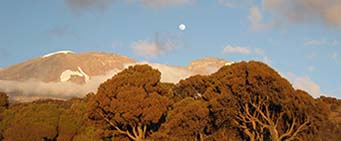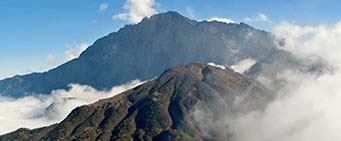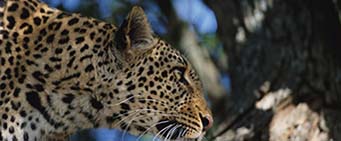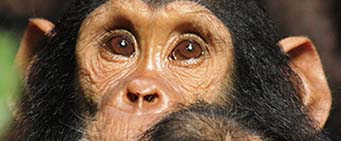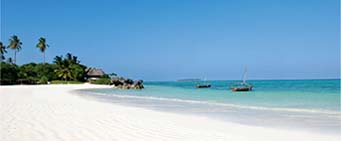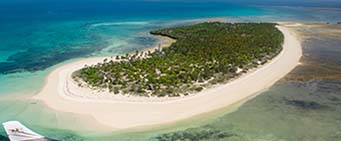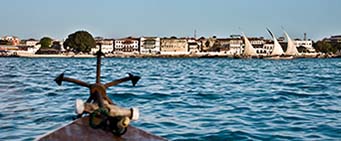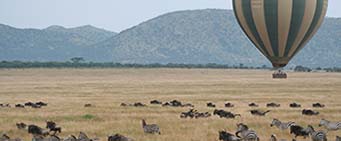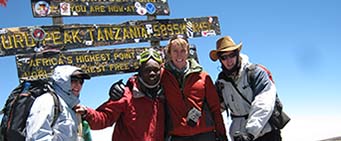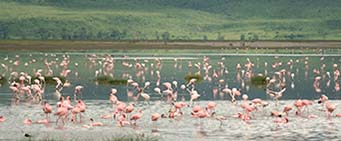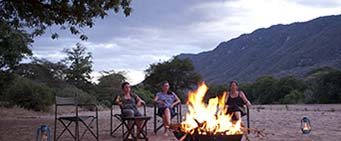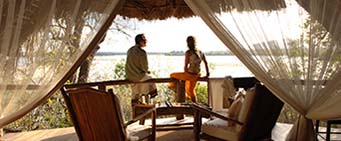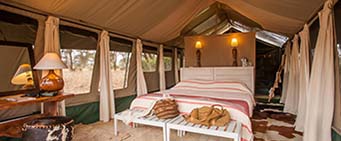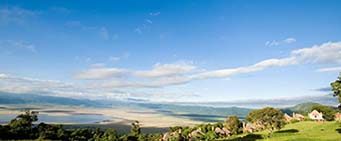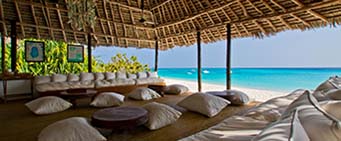This vast East African country really is a dream: within its borders lie Africa’s highest and fifth-highest mountains, the world’s largest intact volcanic caldera, Africa’s most famous national park and the world’s largest game reserve, as well as portions of the three most expansive lakes on the continent, one of which is the second largest freshwater body in the world, another the second deepest.
When it comes to wildlife, Tanzania is without peer. It is here you will see more than 1,000 bird species, Big Five African safari action and the singular spectacle of an annual migration of some two million wildebeest, zebra and gazelle. Modern Tanzania has excellent tourist infrastructure and there is a well worn safari trail or circuit that combines some of Africa’s finest game viewing with the historical old town and superb beaches and islands of the Zanzibar archipelago. Serengeti, Ngorongoro, Mount Kilimanjaro, Zanzibar, all the top destinations are here, but we don’t want you simply ticking them off the list. It’s about fully immersing yourself in the remoter areas of wilderness so you get to spend more time watching wildlife than bus loads of tourists.
Fast Facts
English and Swahili are the major languages and with a population of 47.6 million the majority of people live below the poverty line. Tourism is fast growing with many investors moving in. Trade is in industries like cloves, coffee, cotton, cashew nuts, gold, sisal, minerals and tobacco.
START YOUR SAFARI OR CALL 1300 988 378
Serengeti National Park
It is here in the heart of the Serengeti that you will find a huge variety of wildlife including birds, experience big five encounters and witness the annual migration of some two million wildebeest and zebra throughout the Serengeti Mara ecosystems. The scenery is breathtaking, from grassy plains studded with rugged granite kopjes to rivers and woodlands. In the Serengeti, you’ll fully immerse yourself in the beautiful wilderness and gain a genuine sense of space and the circle of life in what remains one of the greatest national parks in the world.
Ngorongoro Crater
Ngorongoro is an extraordinary Conservation Area that features a volcanic landscape rich and fertile with the stunning Ngorongoro Crater at its centre. The entire area stretches some 8,300 square kilometres through the Crater Highlands, in which local tribes are permitted to maintain their traditional lifestyles in as natural environment as possible. The actual Ngorongoro Crater is one of Africa’s finest wildlife arenas and boasts a blend of landscapes, wildlife, people and archaeology that is unsurpassed in Africa. It is certainly one of the world’s greatest natural spectacles; its magical setting and abundant wildlife never fail to enthral visitors. It borders the Serengeti National Park to the north and west. A few hours’ drive to the east takes you to the town of Arusha which nestles at the foot of Mount Meru, within view of Mount Kilimanjaro. There are two choices of accommodation when considering Ngorongoro Crater. Firstly you can stay high up on the crater rim with views down into the caldera or below the crater in the Karatu area.
Mount Kilimanjaro
The mysterious mountain wreathed in clouds and topped with snow, Kilimanjaro is the highest peak on the African continent, the tallest free standing mountain and completely walkable with a small amount of climbing towards the summit. There are multiple trekking routes to the summit, some more demanding than others. To find out more visit our page on Mount Kilimanjaro.
Mount Meru
Often used as a warm up trek for those seeking to conquer Kilimanjaro, Mount Meru is worthy of a mention because it truly is a magical mountain. Like Kilimanjaro, to summit to its volcanic peak, you first have to trek through numerous vegetation zones before the final night time march to the top, 4,566 metres high with a heavenly view of its big sister. There is a great abundance of wildlife because Meru is within Arusha National Park so your first day is likely to be action packed seeing buffalo, giraffe, elephant, antelope species, warthog and for the lucky, leopard and hyena. This safari-trek should not be under estimated with altitude sickness a threat and more night time scrambling than on Kilimanjaro. Take your time on the mountain to enjoy its beauty. There is only one maion route up Meru and two possible paths on the first day through the national park. We recommend a three or four day trek and can arrange everything for you.
Katavi
A hidden gem, Katavi National Park is ideal for intrepid travellers seeking a Tanzania safari because it really is an isolated, untrammelled and seldom visited wilderness. It is the country’s third largest park in the remote southwest and centres around a series of wide flood plains and network of fragile seasonal rivers where wildlife congregate. Hippo literally in their thousands gather around tiny remaining water pools in dry season and it’s here you will see the famous crocodile cave dwelling – holes dug in the mud so its walls keep them cool. Late dry season can be brutal with predators lining the remaining water holes in anticipation of their prey arriving for a much needed drink. Best time to go is the dry season, May to October and the highlights here are game drives, walks and fly camping.
Mahale Mountains
Located in West Tanzania and home to some of Africa’s last remaining wild chimpanzees, Mahale and neighbouring Gombe offer the opportunity to track through forest to witness these primates in their natural habitat. The population is roughly 900 and they are habituated to human visitors thanks to a research project founded in the 1960s. Mahale has so much more to savour from the Chain of Mountains, Forest fauna and flora, beach relaxation along Lake Tanganyika and the chance to interact with local fishermen and visit villages.
Zanzibar Main island
Unguja, the main Zanzibar island offers outstanding beaches, pristine rainforest and boldly coloured coral reefs below azure waters dotted with traditional dhow sailing boats plus interesting activities like visiting a working spice farm, and the cultural delights of Stone Town, with Arabian fortresses and minarets. Nungwi beach is right on the northern point of the island with lovely white sands. Drawback is many properties are up on coral cliffs so at high tide there is no beach. It’s the most vibrant area with a local village, restaurants and bars. Matemwe in the north ia an expansive, beautiful beach that has become very popular due to its proximity to the island and coral atoll of Mnemba. Kiwengwa and Pongwe offer some of the finest beaches and a good range of properties. As a rule of thumb snorkelling is better the further north you go so Bwejuu and Dongwe in the South East have perhaps some of the most popular beaches on the island yet not the best snorkelling. Tidal range is enormous along the east coast, so low tide creates a hugely vast beach. As high tide arrives, you see why this is paradise.
Zanzibar smaller islands
Zanzibar is made up of a number of islands. We often prefer to get away from the crowds of the main island and experience the smaller islands of Pemba, Mafia and Mnemba. It is no surprise that these islands were once havens for pirates and today offer refuge for global travellers escaping their fast paced world. Cuisine is rich in spices, fresh fruits locally grown and seafood caught daily. Our favourite places to stay on smaller islands are the shabby chic Fundu Lagoon, accessible by boat and set on the stunning south west Pemba Island and Mnemba Island Lodge, offering barefoot luxury at its best surrounded by an atoll of coral reefs.
Zanzibar Stone Town
Stone Town is Zanzibar’s old quarter, a fascinating maze of narrow streets and alleyways which lead the visitor past numerous old houses and mosques, ornate palaces, shops and bazaars. Declared a UNESCO World Heritage Site in 2001, Stone Town is a hotchpotch of cultures, architecture and languages. Over the centuries, Stone Town has grown from a small fishing village on the peninsula of Unguja’s west coast to a thriving town, with an extraordinary history. From as early as 150AD Arab, Asian and Persian traders sailed across the Indian Ocean to trade with the Bantu people, naming the Africa’s east coast as Zinj el Barr, meaning land of the black people, which later became Zanzibar. The cultural melting pot city is the heart of the action with daily markets, a busy port and a myriad of laneways for you to explore! As the day comes to an end, get up high to watch the sunset, you won’t be disappointed.
Browse our Itinerary Collection for Tanzania inspiration
Great Migration
There truly is no beginning or end to the wildebeest migration as it is an endless pilgrimage, a constant search for food and water. In Tanzania, you can witness the mass birthing where literally thousands of young are born in the space of a few weeks between late July and mid March. From here, they move up through the Serengeti ecosystem and cross the Mara River into Kenya usually around September, sometimes as early as late July or August. By November, the herds cross back over the Mara River returning to Tanzania in search of succulent grasses and ultimately, a prime position back in the breeding grounds of Ndutu. Many of our guests like to witness the migration early morning from above, taking off on a hot air balloon safari with bush champagne breakfast included before returning to camp.
Kilimanjaro Climb
A staggering 5,895 metres tall, Kilimanjaro is the highest mountain in Africa. Each year some 50,000 people set out to reach the peak on Africa’s tallest walkable mountain. Whilst you don’t need technical climbing skills or specialist equipment, you do need to really comprehend what awaits you, particularly altitude. We work with the best guide teams to ensure your safety and comfort along the way to the roof of Africa. For those wanting a lesser challenge yet equally rewarding experience we recommend Mount Meru, the second highest mountain in Tanzania at 4566 metres within the Arusha National Park. So you start out in wilderness that is home to a variety of wildlife and summit with views across to Mount Kilimanjaro. Allow 7 to 9 days on Kilimanjaro and 3 to 4 days on Meru.
Bird Watching
A mecca for birders, Tanzania boasts a resident bird population in excess of 1,388 different species and many more that migrate from Europe and Southern Africa. The reason for this is its differing topographies and microclimates. You can spot birds large and small like the enormous Marshall eagle to the petite sunbird. Some birds are elusive and shy like the shoebill and others tend to flock like flamingo. For birders and twitchers alike, check out the Tanzania Bird Atlas. Lake Manyara is a mecca for flamingo at various times of year depending on algae levels. It is a stunning sight to see with resident wildlife also wandering by.
Horseriding Safari
Mainly restricted to private wildlife concessions in northern Tanzania, horse riding safaris are a superb way for experienced riders to get up close to wildlife. The human scent is masked by the horses and there are no engine sounds, so animals seem much more relaxed when you are on horseback safari. Our favourite areas for horseriding safaris are Manyara Ranch Conservancy and Grumeti Reserve. Horses are exceptional quality, tack is provided and guides well trained to ensure both you and the horses are safe. For beach riding, visit one of our personal favourites in a remote stretch of coastline, Ras Kutani to the south of Dar es Salaam. You can also take leisurely horserides at The Manor, Ngorongoro region where onsite stables offer quality horses and tack and you don’t need to be highly experienced as trained guides are with you all the way.
Walking Safaris
Tanzania is keeping up with Zambia and Zimbabwe who once stole the limelight when it came to quality walking safaris. We have some fantastic walking guides in the Selous Game Reserve and Ruaha where you explore a vast range of environments and see great wildlife. In the northern safari circuit of Tanzania, the national parks have finally opened up to allow walking safaris, often at an additional fee. Arusha National Park, Tarangire, Lake Manyara, Ngorongoro Rim and some fringe concessions bordering Serengeti now offer outstanding walking safaris from half day to multi day.
Diving and snorkelling
Tanzania may not rank all that well in the world for best dive sites but there are some great locations for casual marine exploration. Mnemba Island is a small atoll with shallow wall dive down to 18 metres. It has lovely garden reefs and provides a lovely day out with beach picnic for divers and snorkelers alike. Mafia Island is more rewarding and would provide a great location for at least a few days of diving. Here you can cave dive, wall dive, boulder and drift. It’s not ideal for snorkelers as the best reefs are in the outer barrier. Pemba offers larger fish shoals and pelagics that tend to visit here. For wreck diving, there are channel sites off Stone Town.
Dhow Sailing
Whilst on Zanzibar or in Dar es Salaam, we highly recommend heading out on a traditional dhow. It gives you a sense of how people lived on the coast of Africa for years. You will step onboard the wooden dhow vessel and meet your skilled captain and crew before heading out on open waters with the wind in the sails and a cold drink in your hand. Cruise along watching the colours of the water and stop somewhere for a snorkel and picnic lunch if you’re on the full day cruise. Shorter cruises are also available with just refreshments provided rather than snorkel kit and hearty lunch.
Browse our Itinerary Collection for Tanzania inspiration
Manyara Green Camp
Lake Manyara is worthy of more than a day visit and this is our favourite accommodation for those seeking adventure, authentic tented camp and wildlife at your doorstep all within Lake Manyara National Park. Situated on the banks of the Endabash River in the southern reach of Manyara, this simple tented camp sits right on the waterline that never completely dries, meaning wildlife migrate to drink on an almost daily basis. With just five tents, it’s intimate and worth every moment and at dusk, you’ll sit on large pillows in the sand and watch the elephant herds wander in to drink. Large buffalo herds and lion frequent the area at night and by day there is a constant stream of wildlife.
Serengeti Safari Camp
This was the first of its kind, designed to deliver guests a superlative safari experience in an unbeatable location for accessing the great wildebeest migration. It’s like you are an early pioneer, with tented canvas rooms beautifully made up, writing desk, leather and canvas chairs and ensuite bathrooms with bucket showers and long drop loos. It’s small with just six tents so expect personal service and the main area becomes a hub for socialising over a safari drink or meal. There is a dining tent and separate library, lounge and bar tent with fireplace right in front.
Sand Rivers Selous
Designed for comfort and classic safari holidays, this lovely property has just eight open fronted rooms right close to the river’s edge. That means you can enjoy perfect panoramic views from your spacious bedroom, open sided bathroom and, for those staying in one of the three hillside suites, the living area and plunge pool. The main area is really relaxed and staff are friendly so you’ll soon flop on a sofa with your favourite drink in hand to savour the safari holiday romance. This area is explored in multiple ways, hence it’s one of our favourites. You can game drive in 4×4, walk and head out on boats. The highlight for us is the fly camping, venture into remote wilderness and sleep under the stairs under the protection of your guide of course!
Kuro Tarangire
On the banks of the Tarangire River (often dry), this place is in complete harmony with nature’s own tempo. Like migrating wildlife, the camp moves on leaving no footprint behind. That doesn’t mean comfort is compromised, you can still expect authentic safari style with comfortable beds, ensuite bucket showers and flushing eco toilets. Meals are shared under the thatch open sided lounge and dining structure that’s furnished beautifully with hides and canvas. Activities here kick start at dawn and you herald each new day with a walk discovering evidence of the evening wildlife activities. Later it’s a game drive so you can traverse further into Tarangire.
Crater Lodge
This is the uber end of granduer, a somewhat eccentric five star safari lodge perched on the very edge of the Crater rim itself giving you the best views down to the volcanic floor. A high position at a high price is worth it for many because here, you can simply get lost in the brocade sofas, elegant chateau style and dramatic contrasts of European elegance and Maasai magic not to mention experience very friendly service and great food. There are different wings and room categories, all very grand with enormous bedrooms and ensuite bathrooms complete with chandelier lit bath tubs. You are here for the Crater, so we recommend at least 2 nights so you can have time on safari and time to relax and soak up the surrounds of this sensational lodge.
Namiri Plains Camp
This is an uber stylish camp that sits in the eastern corner of the Serengeti. Just six sophisticated tents mean an intimate and exclusive safari experience. Tents offer 360 degree views of wildlife crossing the surrounding plains. Activities are focused on daily game drives plus you can experience breakfast picnics on top of the sensational Soit Le Motonyi Rock. Sunset is savoured with your favourite drink in hand whilst standing high on a kopje (rock) overlooking the plains. This is what defines a luxury safari holiday – the setting and experience!
Mashakiri Palace
Once the seat of the Omani empire, this spectacular Palace was built some 200 years ago by the first sultan and has, more recently been turned into a luxury, boutique hotel. With 18 rooms it doesn’t feel enormous and service is very friendly. You arrive to ground floor with high ceilings and impressive architecture beautifully restored. Check into your luxury room, each slightly different with either sea view, living area or mezzanine floor. Every room is in the old palace wing with thick, cool walls, Arabian beds, carved doors and ensuite bathrooms. The sea view terrace offers a relaxing space to savour sunset and the Kusi bar provides drinks and tapas. Free tea is available daily in the lounge with a selection of savouries and pastries. There is a solarium and hammam offering great treatments and meals are served on the rooftop.
Mnemba Island
Award winning and truly exceptional, this barefoot perfect paradise hosts just 20 guests at any given time in ten beachside bandas that overlook the Mnemba atoll. Here you can do nothing or everything from snorkelling, swimming and kayaking to massages on the beach. Expect outstanding luxury and island surprises from the moment you arrive because this is true elegance. Jaw droppingly beautiful decor adorns both bandas and main areas and everything is done with minimalism and eco friendliness in mind. Rooms are spacious with ensuite bathrooms, stone showers and private verandahs. The main area has dining and lounge and our favourite are the deep pillows and low wooden tables on the beach. Boat sailing, snorkelling, island walks are just a few of the luring activities available.
Pongwe Beach Hotel
Affordable paradise awaits here on Zanzibar. Imagine the perfect white sandy beach, hammocks strung between trees, lapping waters at high tide, beautiful pool for low tide and beach style simple accommodation. Rooms sea view suites with spacious bedroom, ensuite bathroom, sunbeds on your private terrace and private plunge pool. Beach front rooms are the same minus the pool. Garden view rooms are exactly that, the same minus the pool and ocean view, still 30 seconds walk to the beach. There is a great bar and restaurant under large thatched structure and food here is fantastic with an emphasis on seafood. Complimentary activities include kayaking, mountain biking plus there are jeeps for hire, diving and snorkelling excursions and fishing tours.
Browse our Itinerary Collection for Tanzania inspiration
Tanzania holds very special memories to us. To see lions up on the kopjes in the Serengeti and to witness he migration with wildebeests and zebra’s stretching for miles on the plains and the majestic elephants in all the places. We had the best time and experienced the most amazing things on our trip, thank you Encompass Africa.
Nothing beats sailing in a Dhow off the coast of Zanzibar in a stiff breeze, paired with quality underwater sightings. The Encompass Africa team is to be congratulated for the standard and variety of the accommodation in our tailormade African safari.
In a word our trip was amazing!! All of the planning from your end was perfect, our transfers were always there on time, courteous & helpful. We saw many things we weren’t expecting to see, serval cat, bat eared foxes, wildebeest crossing the Grumeti River.
Want to know what others said? Read all our customer ovations.
Get in touch so we can tailor a Tanzania Safari for you today



